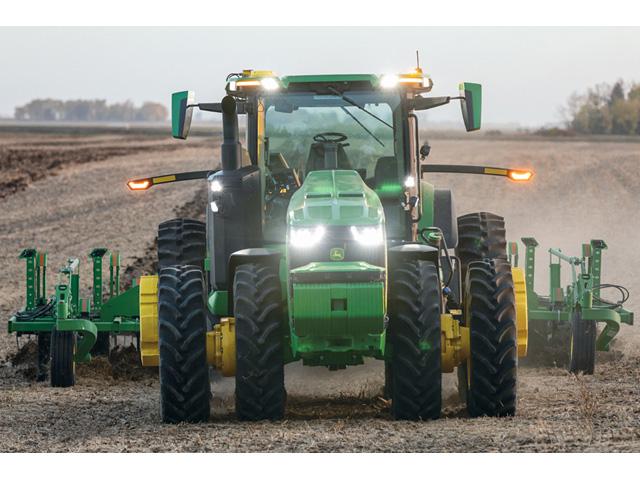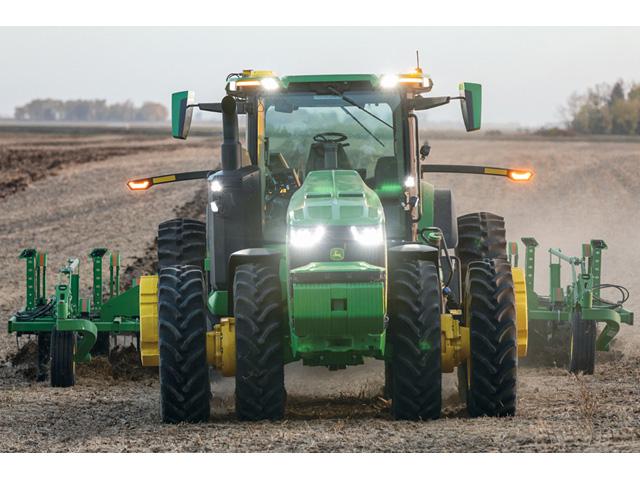MachineryLink
Deere's New Visioning Technology Aims for Fully Autonomous Cropping Fleet by 2030
John Deere has purchased visioning technology properties from AI-startup Light. Light was founded in 2013 and its computer visioning platform is to become an important piece in Deere's expanding fleet of autonomous vehicles.
Currently, Deere is producing the 8R autonomous tractor/TruSet-enabled chisel plow system. It operates with six pairs of stereo cameras -- the eyes -- mounted front and back on the machine, which allow the tractor to perform driverless duties within defined field boundaries. The cameras are the basic sensor that allow the tractor to see what's happening.
Deere has plans for much more. In its Leaps Unlocked Analyst Day on May 26 in Des Moines, Iowa, Deere revealed plans to produce by 2030 the machinery/technology pieces of what will become a complete, full-season-capable autonomous cropping package. That includes spring and fall tillage, planting, spraying and harvesting systems.
Although Deere was vague on the exact autonomous configurations it will produce, one presenter did point to a need for autonomous grain carts and autonomous spraying systems fitted with See & Spray, the technology that allows a Deere sprayer to treat growing crops for individual weeds. The autonomous package, or packages may be configured for corn and soybeans, but also for high value crops, such as grapes, fruits and nuts.
Deere isn't saying much about the intellectual properties acquisition from Light (it did not purchase Light), only that the technology will help "make perception better." There are a couple of published technology pieces with more detail.
The Robot Report said Deere will add Light's Clarity platform to its autonomous tractors.
P[L1] D[0x0] M[300x250] OOP[F] ADUNIT[] T[]
"It appears John Deere is using a vision-only approach to autonomy here," the article stated. "Its new 8R autonomous tractor features six pairs of stereo cameras and doesn't use LiDAR. While LiDAR has become commonplace for autonomous vehicles operating on roads, it appears to be less relevant for navigating a less hectic farm. John Deere also said the vision-based approach is better for identifying and monitoring weeds in real time."
LiDAR -- which stands for light detection and ranging -- is a method for determining ranges by targeting an object or a surface with a laser and measuring the time for the reflected light to return to the receiver. It can be used to make digital 3-D representations of areas on the Earth's surface.
For farming applications, LiDAR may have deficiencies. LiDAR is a good option for automobiles. It gives higher speed, on-road vehicles a second, on-board visioning technology in addition to cameras. But it doesn't perform as well as cameras in dust.
According to its website, Light's multi-camera depth perception platform improves upon existing stereo vision systems by using additional cameras, novel calibration, as well as unique signal processing to provide unprecedented depth quality across the camera field of view.
Light said Clarity uses "signal-processing to build a dense, 3D view of the surrounding environment -- at 30 times a second." Clarity can see 3D structures at a range from 10 centimeters (4 inches) to more than 1,000 meters (1,094 yards).
The Light platform "provides dependable near- and long-range depth information required for machines to make proactive decisions as their environment changes" -- for example, to see weeds at speed and across bumpy fields. Clarity uses a computer-vision approach to self-driving that allows the AI system controlling a vehicle to 'see' the world similarly to the way biological systems do.
The newsletter Neural (property of the Financial Times Company) added to that thought: "In essence, Light's algorithms will allow Deere's equipment to use industry-standard cameras (read: regular old off-the-shelf vision systems) to achieve virtually unparalleled depth perception. That means (Deere) can keep hardware costs low by applying cutting-edge algorithms to gear it potentially already has."
Deere also told Neural "the company expects the acquisition to start paying dividends for Deere customers within the next few months. (Deere) says the company eventually intends to achieve higher speeds with its current autonomy systems and to include more vehicles."
For more information from Light: https://light.co/…
To see the full Neural article: https://thenextweb.com/…
For see The Robot Report article: https://www.therobotreport.com/…
Dan Miller can be reached at dan.miller@dtn.com
Follow him on Twitter @DMillerPF
(c) Copyright 2022 DTN, LLC. All rights reserved.






Comments
To comment, please Log In or Join our Community .